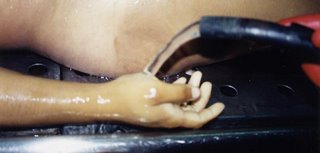
AJ's post below ,and his mention of autopsy and identity, prompted thoughts of what happens to our bodies after we die. Artist Teresa Margolles deals with just such issues in her work in and around the morgues of Mexico City. As the title suggests, Lavado del cuerpo (above) shows a cadavre on a slab being washed. Margolles trained and worked as a forensic technician in a Mexico City morgue before becoming an artists concerned with the "life of the corpse". The poverty and deprivation of life in the City are reflected in the corpses which turn up in the morgue. The victims of volence, drug abuse and the many anonymous dead arrive daily. Margolles' work forcibly removes the distance we would normally place between ourselves and the dead. By eliding life and death, by placing us in the presence of death, she gives new identity to these people. The anonymous cadavre on the slab becomes the subject of her art and we are forced to conside the person beneath the skin. One particularly transgressive example of this in Margolles' work is found in Entierro. The minimal aesthetic of the concrete block in the gallery belies what it contains. What it contains, in fact, is the miscarried foetus of a woman who could not afford to have the child buried. Margolles, it might be said, immortalised the child, placing it at the centre of this work and the centre of our consciousness. Margolles describes her work: "Since the start of my career early in the 90s, I have been working on an aesthetic approach less about death than about corpses in their various phases and their socio-cultural implications. I work on lifeless bodies, with what is decaying, and always start with the question: "How much does a corpse experience?""Her vapourization perfomances (using water which has been used to wash corpses) are particularly chilling. You can read about them here.
No comments:
Post a Comment